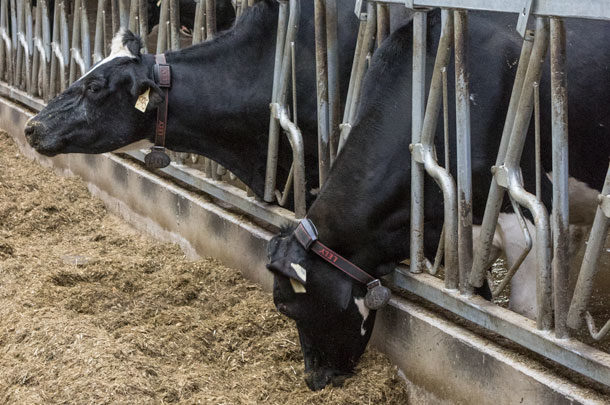Rumination, the cow’s ability to turn food over and over in the stomach in order to digest it, is by far one of the most telling signals the animal has in conveying health status and well-being.However, most dairy producers don’t have time to watch each and every cow “chew it over” after the TMR mixer wagon passes by.
On average, cows ruminate from 400 to 600 minutes per day. Each cow has unique character rumination habits, and a change in routine rumination is almost always noteworthy.
Many dairy producers are now finding success in reading rumination through a stand-alone, long-distance, terminal-based reproduction and health monitoring technology.
Placed high on the cow’s neck, the monitoring system records both multidirectional movement for activity monitoring and rumination sounds to determine rumen health. Any increase in activity or decrease in rumination will be noted, with the two parameters often giving a fairly accurate indication of a cow in heat.
Additionally, rumination monitoring can provide insight into key aspects of the health, reproduction and well-being of individual cows as well as the entire herd.
Recording rumination
It is important for dairy producers to recognize that rumination activity can be disrupted by small errors in husbandry and management. Cows can control rumination and stop whenever they are disrupted or stressed.
For example, overcrowding in the freestall pens, dry cow facilities and close-up pens, and erratic feeding, can affect rumination and can also:
- Decrease the cow’s saliva production, increasing the need to supplement sodium bicarbonate
- Reduce hours cows are adequately resting, which in turn can cause increased stress on hooves, less blood flow to the uterus and decreased milk yield
- Increase somatic cell count
- Escalate the number of clinical mastitis cases
- Intensify slug feeding, which can decrease the percentage of body fat and percentage of protein in the diet
When rumination drops, it is a clear indication that the cow is uncomfortable and potentially ill. A plunge in rumination minutes is often seen before a slump in milk production.
A healthy cow will ideally return to her target rumination within six to seven days post-calving. Cows with lower levels of rumination in the first week will likely become acute with a post-calving disorder a few days later.
By monitoring the cow’s rumination in the immediate post-fresh period, it is possible to identify an early indication of a potential health problem and treat it quickly to potentially lessen the amount of time until recovery, leading to fewer ramifications for milk production over the entire lactation.
Some management areas to consider for creating a ruminating-friendly atmosphere:
- After periods of high feed intake, allocate more time for cows to spend ruminating.
- Do not restrict dry matter intake, as it reduces rumination.
- Allow plenty of time for lying down, as rumination typically occurs during resting periods.
- Offer plenty of space for the cow to find a favourite resting position, often a left-side preference.
- Ensure the herd is getting enough time for sleep, as this is a critical period for metabolic and immune functions.
Selecting a menu for rumination
Healthy rumens yield healthy profits; therefore, it is essential to feed the rumen microbes to promote good health. Producers should include fibrous feedstuffs such as grass and hay in their herds’ diets, as these ingredients are necessary to stimulate rumen mixing, rumination and saliva production for buffering. Inadequate ruminal adaptation to highly fermentable diets, such as in early lactation, can also lead to subacute ruminal acidosis (SARA).
Transition diets should provide adequate forage fibre while progressively introducing grains three weeks before and after calving to allow for proper adaption to highly fermentable diets. To ensure the effectiveness of a well-balanced TMR, management practices that promote rumen stability and minimize the risk of acidosis should be maintained.
These include proper processing and mixing of the TMR to ensure adequate particle size and effective fibre, maintaining consistent feed delivery times, minimizing sorting at the feedbunk, allowing adequate bunk space to avoid slug feeding and ensuring animal comfort.
Promote a healthy rumen microbial ecosystem with rumen-friendly, forage-based diets. Consider the use of live yeast. Yeast supplementation before calving and in combination with buffers post-calving have shown to be an effective strategy to reduce the risk of ruminal acidosis in transition cows.
The addition of yeast increases the ruminal bacterial count, initial rate of fibre digestion in the rumen and flow of microbial protein from the rumen. This results in increased feed intake and improved feed efficiency. Strain, number and viability of cells, and scientifically proven activity in the rumen should be considered when choosing a yeast supplement.
The high cost of vegetable proteins, as well as environmental concerns about the excretion of excess nitrogen, demonstrate the need for the development of feeding strategies and protein supplements that improve protein utilization in ruminants.
Dairy producers should consult with their nutritionists about adding slow-release, non-protein nitrogen to efficiently meet the nitrogen requirement of rumen microbes, specifically the fibre-digesting bacteria, and to replace vegetable proteins in the ration.
Another component to add is a microbial protein with a high-quality amino acid profile, similar to rumen microbes, fed primarily to meet the amino acid requirements of high-producing cows.
Management and nutritional changes affecting a group or the entire herd can be monitored and administered by scrutinizing the rumination averages and patterns through monitoring technology. Constant rumination monitoring and management can optimize not only the individual lactation curve but also the entire herd production curve. PD
PHOTO: Constant rumination monitoring and management can optimize not only the individual lactation curve but also the entire herd production curve. Photo provided by Mike Dixon.

-
Tom Lorenzen
- On-farm Specialist
- Alltech
- Email Tom Lorenzen











